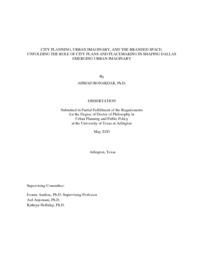| dc.description.abstract | This research addresses the gap in the literature that intersects city planning and city branding by examining how “urban imaginaries” through placemaking projects are constructed, in particular regarding cities with a legacy of stigma. This inquiry has wide-ranging economic implications for municipal governments since the way a city is being represented or branded could either attract or repel capital, tourists, and future residents, which could, in turn, affect economic growth.
I draw upon two key concepts that drive this research. First, based on the symbolic economy, I refer to urban imaginaries as the ways that a city can be imagined and represented through images, symbols, and narratives. The city’s physical structures such as art museums, public parks, and cultural districts produce visual images that shape urban imaginaries. The second concept is “urban imagineers,” which I define as representative of those professionals who engage in the social construction of urban imaginaries and branding the city through their practice. Municipal planners by co-developing the city’s alternative visions, architects by designing iconic landmarks, and city boosters (e.g., real estate developers) by promoting pro-growth civic agendas constitute urban imagineers.
This research argues that city plans play an important role in shaping urban imaginaries and the city’s brand through visions that legitimize a physical determinism often heavily advocated by city boosters. By proposing large-scale placemaking projects—urban design interventions in the city’s landscape—municipal planners, architects, and city boosters, inadvertently or not, promote urban imaginaries that are consistent with growth narratives publicized by civic leaders.
I select a single-case study research design, focusing on the City of Dallas as a unique case; since the early 1900s, Dallas has become a booster city and turned to entrepreneurialism. Despite the city’s struggle with legacies of stigma linked to the JFK assassination in 1963, Dallas has sustained its entrepreneurial spirit with increasing investment in both symbolic and material cultural flagship projects. The main sources of data include existing literature on Dallas, city plans prepared for Dallas over the past century, D-Magazine archival issues since 1974, and semi-structured interviews with key informants as representative of urban imagineers (i.e., municipal planners, architects, and city boosters). Architecture critics and historians are also recruited to uncover the nature of placemaking projects and the historical context behind city plans, accordingly.
Using a content analysis of city plans and the extant literature on Dallas, research findings first identify three eras as influential in the historical lineage of Dallas’s city planning: 1900—1963, 1963—1990, and 1990 onward, each with a prevalent political discourse. Next, by consulting key informants, I validate my findings of key placemaking projects that have shaped Dallas’s urban imaginaries: Fair Park, DFW Airport, Reunion Tower, The Arts Districts, Klyde Warren Park, and The Trinity River Corridor. I argue that city plans have largely tended to serve the power elites and legitimized their ambition of constructing these placemaking projects. Finally, I find that Dallas’s branded space has expanded, both symbolically and geographically, over those three eras. The city’s branded space shaped by urban imagineers has shifted from the oil industry represented by “Pegasus” and limited to city’s physical boundary to the narrative of “world-class” in the new millennium, transcending the city and even the metroplex. This research concludes by drawing some lessons and discussing policy implications for municipal planners and policymakers. | |


